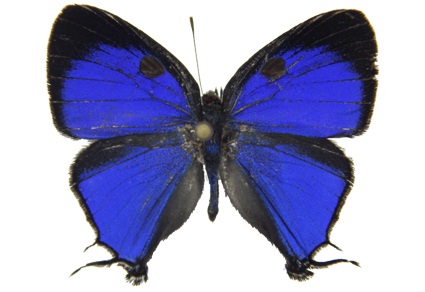Abstract
We present evidence from DNA barcodes, wing pattern and distribution to support the hypothesis that an entity flying in sympatry with Thaeides theia in the Sierra Nevada de Santa Marta, is an undescribed biological species named herein as Thaides ramoni Prieto, sp. nov. Adult specimens and genital structures are illustrated for both species along with molecular and morphological diagnostic characters. In addition, we present some considerations about the taxonomy of the species in the Thaeides muela group.
References
- Busby, R.C., Faynel, C., Moser, A. & Robbins, K. (2017) Sympatric Diversification in the Upper Amazon: A Revision of the Eumaeine Genus Paraspiculatus (Lepidoptera: Lycaenidae). Smithsonian Contributions to Zoology, 649, i–vii + 1–65. https://doi.org/10.5479/si.1943-6696.649
- D’Abrera, B., Bálint Z. (2022) Pillangóvilág. Bevezetés és a teremtett sokféleség rendje. [World Butterflies. Introduction and order of the created diversity.] Pytheas könyvmanufaktúra, Budapest, 112 pp.
- deWaard, J.R., Ivanova, N.V., Hajibabaei, M. & Hebert, P.D.N. (2008) Assembling DNA barcodes: analytical protocols,. In: Martin, C. (Ed.), Methods in molecular biology: environmental genetics. Humana Press Inc, Totowa, New Jersey, pp. 275–293. https://doi.org/10.1007/978-1-59745-548-0_15
- Faynel, C., Busby, R.C. & Robbins, R.K. (2012) Review of the Species Level Taxonomy of the Neotropical Butterfly Genus Oenomaus (Lycaenidae, Thecli nae, Eumaeini). ZooKeys, 222, 11–45. https://doi.org/10.3897/zookeys.222.3375
- Fedosov, A., Achaz, G. & Puillandre, N. (2019) Revisiting use of DNA characters in taxonomy with MolD - a tree independent algorithm to retrieve diagnostic nucleotide characters from monolocus datasets. bioRxiv, 2019, 838151 https://doi.org/10.1101/838151
- Kumar, S., Stecher, G. & Tamura, K. (2016) MEGA7: Molecular Evolutionary Genetics Analysis version 7.0 for bigger datasets. Molecular Biology and Evolution, 33, 1870–1874. https://doi.org/10.1093/molbev/msw054
- Prieto, C., Nuñez, R. & Hausmann, A. (2018) Molecular species delimitation in the genus Rhamma Johnson, 1992 (Lepidoptera: Lycaenidae, Theclinae). Mitochondrial DNA, 30 (1), 1–17. https://doi.org/10.1080/24701394.2018.1462348
- Prieto, C., Faynel, C. & Lorenc-Brudecka, J. (2023) Integrative description of two new species and two new subspecies of Lamprospilus Geyer (Lepidoptera: Lycaenidae). Zootaxa, 5244 (2), 145–159. https://doi.org/10.11646/zootaxa.5244.2.3
- Puillandre, N., Lambert, A., Brouillet, S. & Achaz, G. (2012) ABGD, Automatic Barcode Gap Discovery for primary species delimitation. Molecular Ecology, 21, 1864–1877. https://doi.org/10.1111/j.1365-294X.2011.05239.x
- Puillandre, N., Brouillet, S. & Achaz, G. (2021) ASAP: assemble species by automatic partitioning. Molecular Ecology Resources, 21, 609–620. https://doi.org/10.1111/1755-0998.13281
- Robbins, R.K. (1991) Evolution, comparative morphology, and identification of the Eumaeini butterfly genus Rekoa Kaye (Lycaenidae. Theclinae), Smithsonian Contributions to Zoology, 498, 1–64. https://doi.org/10.5479/si.00810282.498
- Robbins, R.K. (2004) Introduction to the Checklist of Eumaeini, Lycaenidae. In: Lamas, G. (Ed.), Checklist of Neotropical Lepidoptera. Part 4A. Hesperoidea-Papilionoidea. In: Heppner, J.B. (Series Ed.), Atlas of Neotropical Lepidoptera. Scientific publishers, Gainesville, Florida, pp. xxiv–xxx.
- Robbins, R.K. & Busby, R.C. (2015) Evolutionary gain of male secondary sexual structures in the widespread neotropical montane genus Lathecla (Lepidoptera, Lycaenidae, Eumaeini). Insect Systematics & Evolution, 46, 47–78. https://doi.org/10.1163/1876312X-45032115
- Robbins, R.K., Martins, A.R., Busby, R.C. & Duarte, M. (2012) Loss of Male Secondary Sexual Structures in Allopatry in the Neotropical Butterfly Genus Arcas (Lycaenidae: Theclinae: Eumaeini). Insect Systematics & Evolution, 43, 35–65. https://doi.org/10.1163/187631212X626195
- Robbins, R.K., Cong, Q., Zhang, J., Shen, J., Busby, R.C., Faynel, C., Duarte, M., Martins, A.R.P., Prieto, C., Lamas, G. & Grishin, N.V. (2022) Genomics-based higher classification of the species-rich hairstreaks (Lepidoptera: Lycaenidae: Eumaeini). Systematic Entomology, 47 (3), 445–469.
- Vargas, H.A. & Duarte, M. (2014) First host plant record for Thaeides muela (Lepidoptera: Lycaenidae: Theclinae: Eumaeini). Florida Entomologist, 97 (1), 288–290. https://doi.org/10.1653/024.097.0142
- Vences, M., Miralles, A., Brouillet, S., Ducasse, J., Fedosov, A., Kharchev, V., Kumari, S, Patmanidis, S., Puillandre, N., Scherz, M.D., Kostadinov, I. & Renner, S.S. (2021) iTaxoTools 0.1: Kickstarting a specimen-based software toolkit.for taxonomists. Megataxa, 6 (2), 77–92. https://doi.org/10.11646/megataxa.6.2.1
- Winter, W.D. (2000) Basic Techniques for Observing and Studying Moths and Butterflies. The Lepidopterists’ Society, Memoir 5, i–xviii + 1–444.
- Warren, A.D., Davis, K.J., Stangeland, E.M., Pelham, J.P. & Grishin, N.V. (2012) Illustrated list of American butterflies. Available from: http://butterfliesofamerica.com (accessed 16 August 2024)
- Zhang, J., Kapli, P., Pavlidis, P. & Stamatakis, A. (2013) A general species delimitation method with applications to phylogenetic placements. Bioinformatics, 29, 2869–2876. https://doi.org/10.1093/bioinformatics/btt499


